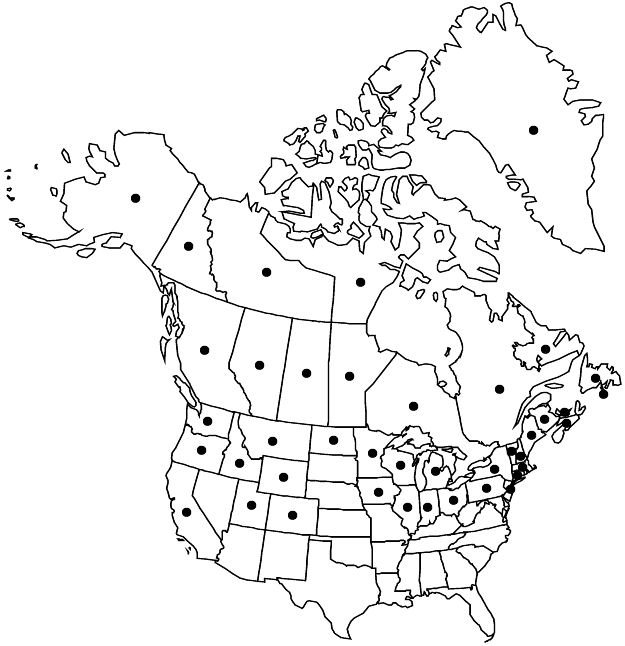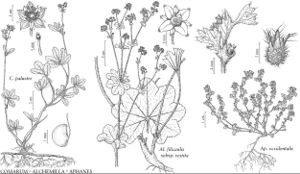Difference between revisions of "Comarum palustre"
Sp. Pl. 1: 502. 1753.
FNA>Volume Importer |
imported>Volume Importer |
||
| (5 intermediate revisions by 2 users not shown) | |||
| Line 10: | Line 10: | ||
|special_status={{Treatment/ID/Special_status | |special_status={{Treatment/ID/Special_status | ||
|code=F | |code=F | ||
| − | |label= | + | |label=Illustrated |
}} | }} | ||
|basionyms= | |basionyms= | ||
| Line 16: | Line 16: | ||
|name=Comarum palustre subsp. angustifolium | |name=Comarum palustre subsp. angustifolium | ||
|authority=(Rafinesque) Tzvelev | |authority=(Rafinesque) Tzvelev | ||
| + | |rank=subspecies | ||
}} {{Treatment/ID/Synonym | }} {{Treatment/ID/Synonym | ||
|name=C. palustre subsp. arcticum | |name=C. palustre subsp. arcticum | ||
|authority=(Gandoger) Tzvelev | |authority=(Gandoger) Tzvelev | ||
| + | |rank=subspecies | ||
}} {{Treatment/ID/Synonym | }} {{Treatment/ID/Synonym | ||
|name=Fragaria palustris | |name=Fragaria palustris | ||
| − | |authority= | + | |authority= |
| + | |rank=species | ||
}} {{Treatment/ID/Synonym | }} {{Treatment/ID/Synonym | ||
|name=Potentilla palustris | |name=Potentilla palustris | ||
| − | |authority= | + | |authority= |
| + | |rank=species | ||
}} {{Treatment/ID/Synonym | }} {{Treatment/ID/Synonym | ||
|name=P. palustris var. parvifolia | |name=P. palustris var. parvifolia | ||
|authority=(Rafinesque) Fernald & B. H. Long | |authority=(Rafinesque) Fernald & B. H. Long | ||
| + | |rank=variety | ||
}} {{Treatment/ID/Synonym | }} {{Treatment/ID/Synonym | ||
|name=P. palustris var. villosa | |name=P. palustris var. villosa | ||
|authority=(Persoon) Lehmann | |authority=(Persoon) Lehmann | ||
| + | |rank=variety | ||
}} | }} | ||
|hierarchy=Rosaceae;Rosaceae subfam. Rosoideae;Rosaceae tribe Potentilleae;Comarum;Comarum palustre | |hierarchy=Rosaceae;Rosaceae subfam. Rosoideae;Rosaceae tribe Potentilleae;Comarum;Comarum palustre | ||
| Line 57: | Line 63: | ||
-->{{#Taxon: | -->{{#Taxon: | ||
name=Comarum palustre | name=Comarum palustre | ||
| − | |||
|authority=Linnaeus | |authority=Linnaeus | ||
|rank=species | |rank=species | ||
| Line 71: | Line 76: | ||
|publication title=Sp. Pl. | |publication title=Sp. Pl. | ||
|publication year=1753 | |publication year=1753 | ||
| − | |special status= | + | |special status=Illustrated |
| − | |source xml=https:// | + | |source xml=https://bitbucket.org/aafc-mbb/fna-data-curation/src/2e0870ddd59836b60bcf96646a41e87ea5a5943a/coarse_grained_fna_xml/V9/V9_488.xml |
|subfamily=Rosaceae subfam. Rosoideae | |subfamily=Rosaceae subfam. Rosoideae | ||
|tribe=Rosaceae tribe Potentilleae | |tribe=Rosaceae tribe Potentilleae | ||
Latest revision as of 22:57, 5 November 2020
Stems 1–10(–18) dm. Leaves: petiole 5–10(–15) cm; leaflets usually abaxially glaucous, adaxially green, sometimes silvery-silky, often aging reddish, 1.5–10(–12) × (0.8–)1–5 cm. Pedicels 5–25(–30) mm. Flowers: epicalyx bractlets narrowly lanceolate to lanceolate, 2–7(–9) mm, usually equal to or shorter than sepals; sepals greenish purple adaxially, (5–)7–12(–14) mm, apex acuminate; petals 2.5–6(–8) mm; anthers dark purple, 0.8–1.2 mm, connectives thickened, greenish purple to purple; styles 0.9–2 mm. 2n = 28, (35)36, 42, (60, 62, 63)64.
Phenology: Flowering summer.
Habitat: Shallow, often sphagnum-dominated ponds, bogs, wet meadows, marshes, stream banks, and lake margins, mainly in boreal and low arctic habitats in the north, subalpine to alpine sites in the south
Elevation: 0–3100 m
Distribution

Greenland, St. Pierre and Miquelon, Alta., B.C., Man., N.B., Nfld. and Labr., N.W.T., N.S., Nunavut, Ont., P.E.I., Que., Sask., Yukon, Alaska, Calif., Colo., Conn., Idaho, Ill., Ind., Iowa, Maine, Mass., Mich., Minn., Mont., N.H., N.J., N.Y., N.Dak., Ohio, Oreg., Pa., Utah, Vt., Wash., Wis., Wyo., Eurasia.
Discussion
Comarum palustre is circumboreal; it occurs in a broad band across the northernmost United States and Canada as far north as the low arctic. Disjunct populations occur well to the north, as on Baffin and Victoria islands, and in the south, as in Gunnison County, Colorado, and the Uinta Mountains of Utah. Appropriate habitats are uncommon and geographically restricted in the southern part of the range, for example, in Idaho, Montana, and North Dakota.
Comarum palustre is sometimes divided into subspecies, varieties, and/or forms on the basis of vestiture, leaflet dimensions, and flower number (for example, M. L. Fernald and B. H. Long 1914; N. N. Tzvelev 2007). Because there is no existing consensus, and a global evaluation of the situation is beyond the scope of this work, no infraspecific taxa are recognized here. Within North America, northern populations tend to have broader leaflets and inflorescences composed of one to relatively few flowers with relatively short sepals and petals, but these differences are not consistent; similar plants occur in subalpine settings in the mountains well to the south. Chromosome numbers also vary, apparently not correlated with morphology or geography; some populations occasionally include individuals of different disploid and polyploid levels.
Horizontal stems were used occasionally by Native Americans as a medicinal aid in the treatment of dysentery and stomach cramps (D. E. Moerman 1998). Aquatic birds in particular eat the leaves and achenes.
Selected References
None.
